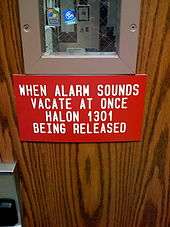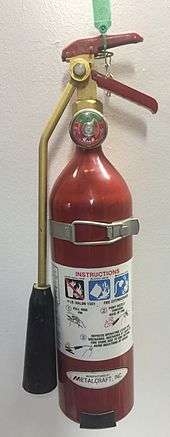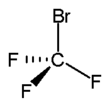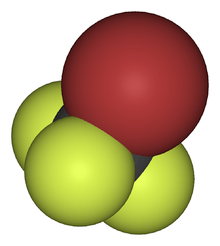Bromotrifluoromethane
Bromotrifluoromethane, commonly known as Halon 1301, R13B1, Halon 13B1 or BTM, is an organic halide with the chemical formula CBrF3. It is used for fire suppression. Relative to other fire suppressing agents, such as bromochloromethane, it is far less toxic.[3]
| |||
| Names | |||
|---|---|---|---|
| Preferred IUPAC name
Bromo(trifluoro)methane | |||
Other names
| |||
| Identifiers | |||
3D model (JSmol) |
|||
| ChemSpider | |||
| ECHA InfoCard | 100.000.807 | ||
| EC Number |
| ||
PubChem CID |
|||
| RTECS number |
| ||
| UNII | |||
| UN number | 1009 | ||
CompTox Dashboard (EPA) |
|||
| |||
| |||
| Properties | |||
| CBrF3 | |||
| Molar mass | 148.910 g·mol−1 | ||
| Appearance | Colorless gas | ||
| Odor | Odorless[1] | ||
| Density | 1.538 g/cm3 (at −58 °C (−72 °F)) | ||
| Melting point | −167.78 °C (−270.00 °F; 105.37 K) | ||
| Boiling point | −57.75 °C (−71.95 °F; 215.40 K) | ||
| 0.03 g/l (20 °C (68 °F)) | |||
| log P | 1.86 | ||
| Vapor pressure | 1434 kPa (20 °C (68 °F)) | ||
| Hazards | |||
| Flash point | Non-flammable | ||
| Lethal dose or concentration (LD, LC): | |||
LCLo (lowest published) |
834,000 ppm (rat, 15 min)[2] | ||
| NIOSH (US health exposure limits): | |||
PEL (Permissible) |
TWA 1000 ppm (6100 mg/m3)[1] | ||
REL (Recommended) |
TWA 1000 ppm (6100 mg/m3)[1] | ||
IDLH (Immediate danger) |
40,000 ppm[1] | ||
Except where otherwise noted, data are given for materials in their standard state (at 25 °C [77 °F], 100 kPa). | |||
| Infobox references | |||
Table of physical properties
| Property | Value |
|---|---|
| Critical temperature (Tc) | 66.9 °C (340.08 K) |
| Critical pressure (pc) | 3.956 MPa (39.56 bar) |
| Critical density (ρc) | 5.13 mol.l−1 |
| Ozone depletion potential (ODP) | 10 (CCl3F = 1) |
| Global warming potential (GWP) | 6900 (CO2 = 1) |
Uses


Halon 1301 was developed in a joint venture between the U.S. Army and DuPont in 1954, and introduced as an effective gaseous fire suppression fixed systems agent in the 1960s, and was used around valuable materials, such as aircraft, mainframe computers, and telecommunication switching centers, usually in total flooding systems. It was also widely used in the maritime industry to add a third level of protection should the main and emergency fire pumps become inoperable or ineffective. Halon 1301 was never widely used in portables outside military and spacecraft applications, due to its limited range, and invisible discharge. It does not produce the characteristic white cloud like CO2 and is difficult to direct when fighting large fires. Halon 1301 is ideal for armored vehicles and spacecraft, however, because it produces fewer toxic by-products than does Halon 1211, which is critical for combat or space conditions where a compartment may not be able to be ventilated immediately. Halon 1301 is widely used by the U.S. Military and NASA in a 2-3/4 lb portable extinguisher with a sealed, disposable cylinder for quick recharging. Other agents such as CO2 and E-36 Cryotech wet chemical are largely replacing halon 1301, however, due to environmental concerns. Civilian models in 2-3/4, 3, and 4 lb sizes were also made.
It is considered good practice to avoid all unnecessary exposure to Halon 1301, and to limit exposures to concentrations of 7 percent and below to 15 minutes. Exposure to Halon 1301 in the 5 to 7 percent range produces little, if any, noticeable effect. At levels between 7 and 10 percent, mild central nervous system effects such as dizziness and tingling in the extremities have been reported.[4] In practice, the operators of many Halon 1301 total flooding systems evacuate the space on impending agent discharge.
Halon systems are among the most effective and commonly used fire protection systems used on commercial aircraft. Halon 1301 is the primary agent used in commercial aviation engine, cargo compartments, and auxiliary power unit fire zones.[5][6] Efforts to find a suitable replacement for Halon 1301 have not produced a widely accepted replacement.[7] [8]
Bromotrifluoromethane was also used as a filling of the bubble chamber in the neutrino detector Gargamelle.
Before the dangers of Halon 1301 as an ozone depleter were known, many industrial chillers used it as an efficient refrigerant gas.[9]
Chemical reagent
It is a precursor to trifluoromethyltrimethylsilane, a popular trifluoromethylating reagent in organic synthesis.[10]
Alternatives
Alternatives for normally occupied areas include (PFC-410 or CEA-410), C3F8 (PFC-218 or CEA-308), HCFC Blend A (NAF S-III), HFC-23 (FE 13), HFC-227ea (FM 200), IG-01 (argon), IG-55 (argonite), HFC-125, or HFC-134a. For normally unoccupied areas, the alternatives include carbon dioxide, powdered Aerosol C, CF3I, HCFC-22, HCFC-124, HFC-125, HFC-134a, gelled halocarbon/dry chemical suspension (PGA), blend of inert gas, high expansion foam systems and powdered aerosol (FS 0140), and IG-541 (Inergen).[11] Perfluorocarbons, i.e., PFCs such as C3F8, have very long atmospheric lifetimes and very high global warming potentials. Hydrochlorofluorocarbons, i.e., HCFCs including HCFC containing NAF S-III, contain chlorine and are stratospheric ozone layer depleters, although less so than Halon 1301. Their selection for usage as Halon replacements should consider those factors, and is restricted in some countries.
See also
- Halon 1211
- Fire extinguisher
- Montreal Protocol
References
- NIOSH Pocket Guide to Chemical Hazards. "#0634". National Institute for Occupational Safety and Health (NIOSH).
- "Trifluorobromomethane". Immediately Dangerous to Life and Health Concentrations (IDLH). National Institute for Occupational Safety and Health (NIOSH).
- Dagani, M. J.; Barda, H. J.; Benya, T. J.; Sanders, D. C. "Bromine Compounds". Ullmann's Encyclopedia of Industrial Chemistry. Weinheim: Wiley-VCH. doi:10.1002/14356007.a04_405.
- NFPA 12A Standard on Halon 1301 Fire Extinguishing Systems, 2004 Edition / Annex D, Hazards to Personnel , section D.2.2
- [ https://www.epa.gov/sites/production/files/2015-07/documents/guidance_for_halon_emissions_reduction_rule_40_cfr_part_82_subpart_h.pdf United States Environmental Protection Agency | Guidance for the EPA Halon(R) Emission Reduction Rule | Federal Aviation Administration]
- Boeing Commercial Aeromagazine | Quarter 04, 2011 | Replacing Halon in Fire Protection Systems: a Progress report
- Aerospace Manufacturing and Design | Halon Alternatives for Aircraft Propulsion Systems consortium formed | January 27, 2015
- FAA | Task Group on Halon Options
- "National Refrigerants MSDS" (PDF). Archived from the original (PDF) on 2011-02-08. Retrieved 2009-07-17.
- Ramaiah, Pichika; Krishnamurti, Ramesh; Prakash, G. K. Surya (1995). "1-Trifluoromethyl-1-cyclhexanol". Org. Synth. 72: 232. doi:10.15227/orgsyn.072.0232.
- Halon 1301 Replacements Archived 2008-04-19 at the Wayback Machine
External links
- International Chemical Safety Card 0837
- NIOSH Pocket Guide to Chemical Hazards. "#0634". National Institute for Occupational Safety and Health (NIOSH).
- MSDS sheet at airliquide.com
- FAA paper on testing cylinders used to store Halon 1301 without breaking their seals (pdf)
- MSDS for bromotrifluoromethane (pdf)
- MSDS at ansul.com (pdf)
- Toxicokinetics of Inhaled Bromotrifluoromethane (Halon 1301) in Human Subjects
- Effect of CF3H and CF3Br on laminar diffusion flames in normal and microgravity
- Basic Facts about Halon

